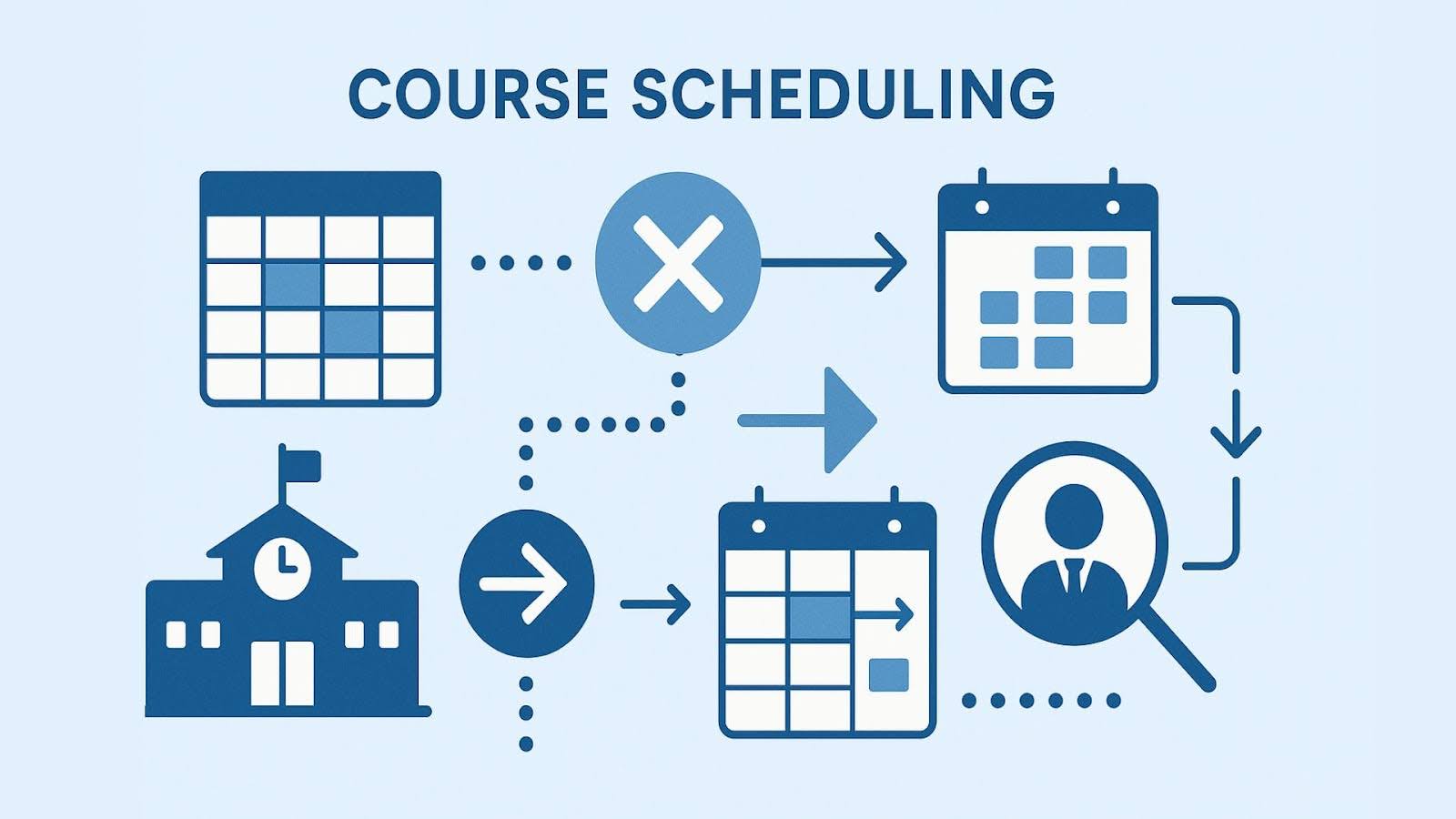How to Choose a Course Scheduling System for Your University
It's registration week, and your campus is buzzing with frustrated students trying to build their schedules. At the same time, your registrar's office is fielding hundreds of calls about course conflicts, waitlist questions and room assignment errors. Sound familiar? You're not alone.
Fall 2024 enrollment data shows that while undergraduate enrollment rose 3% from the previous year, institutions are facing new pressures to streamline operations and maximize efficiency. The stakes have never been higher for getting your course scheduling system right.
The truth is, your course scheduling system is the backbone of your entire academic operation. Getting it wrong can result in scheduling conflicts, resource waste and decreased student satisfaction. Getting it right can unlock efficiency gains that ripple through every corner of your institution.
So, how do you cut through the vendor marketing speak and choose a system that actually works for your unique needs? Let's discover what it takes to achieve success.
Understanding Your Institution's Scheduling Complexity
Before you start comparing features and pricing, honestly assess what you're working with. Every university has its own scheduling DNA, a unique combination of academic programs, student populations, facility constraints and administrative quirks that make your needs different from the school down the road.
Start by mapping your current scheduling process. Who's involved? How many hands does a single course schedule pass through before it's finalized? According to EDUCAUSE research, one institution discovered they were using 111 steps and 30 different technologies for their enrollment process, eventually streamlining it down to 35 steps and 16 technologies.
Think about your stakeholders too. Faculty want schedule flexibility and workload balance. Students need courses that fit their work schedules and degree plans. Administrators require compliance with accreditation standards and budget constraints. Your registrar's office needs conflict-free schedules that don't require constant manual intervention.
Don't forget about scale. A community college with 5,000 students has vastly different needs than a research university with 40,000. Your system needs to handle today's enrollment and accommodate future growth without breaking your budget or overwhelming your staff.
6 Essential Features Your Course Scheduling System Must Have

Here's where we separate the must-haves from the nice-to-haves. Based on what actually matters for smooth academic operations, your system should include these core capabilities:
1. Automated Conflict Detection and Resolution
Your system should catch schedule conflicts before they become student headaches. This means identifying overlapping class times, double-booked classrooms and instructor availability issues in real time. The best systems flag conflicts and suggest solutions.
2. Integration with Student Information Systems
Standalone systems create data silos and duplicate work. Your course scheduling platform should sync seamlessly with your SIS, automatically pulling student records, academic histories and enrollment data. This integration eliminates manual data entry and reduces errors that can derail registration periods.
3. Flexible Room and Resource Management
Beyond basic classroom assignments, look for systems that handle specialized spaces like labs, studios and clinical facilities. Your platform should track equipment needs, capacity constraints and accessibility requirements. Some institutions have unique needs, such as nursing programs that require simulation labs or engineering courses that need specific software.
4. Faculty Preference Management
About one-third of higher ed faculty members are likely to seek new employment within a year. Happy faculty make for smoother operations. Your system should collect and incorporate instructor preferences for teaching times, course loads and classroom types. While you can't accommodate every request, having this data helps you make informed decisions and maintain faculty satisfaction.
5. Real-Time Updates and Communication
Schedule changes happen. A lot. Your system should handle last-minute adjustments without creating a cascade of problems. Look for platforms that automatically notify affected parties when changes occur and simultaneously update all relevant systems.
6. Robust Reporting and Analytics
Data-driven decision-making is essential for optimizing your course scheduling efficiency. Your system should provide insights into room utilization, enrollment patterns, faculty workloads and student success metrics.
Implementation and Integration Considerations
Choosing the right system is only half the battle. Implementation can make or break your investment, so you need to think strategically about the transition process.

Technical integration is your first hurdle. How well does the new system play with your existing technology stack? You'll need seamless data flow between your course scheduling platform, SIS, learning management system and financial aid systems. Ask potential vendors for detailed integration specifications and reference installations at similar institutions.
Timeline expectations matter too. Implementation timelines typically range from 6–12 months for mid-sized institutions. However, your timeline may vary based on your system's complexity and integration requirements. Plan for this duration in your academic calendar. You don't want to be testing a new system during peak registration periods.
Change management often gets overlooked, but it's critical for success. Your staff will need training on new workflows, and faculty may resist changes to familiar processes. Factor in time and resources for comprehensive training programs and ongoing support. The most sophisticated system won't help if no one knows how to use it effectively.
Total Cost of Ownership Evaluation
Sticker shock is real in higher education technology, but the cheapest option often costs more in the long run. When evaluating costs, look beyond the initial license fees to understand your total investment.
Total Cost of Ownership Evaluation
Sticker shock is real in higher education technology, but the cheapest option often costs more in the long run. When evaluating costs, look beyond the initial license fees to understand your total investment.
Most vendors use subscription pricing models, with costs typically based on student enrollment or the number of courses scheduled. Factor in implementation fees, which can range from a few thousand dollars for simple setups to six figures for complex, multi-campus installations.
Don't forget about ongoing costs like training, support and system maintenance. Some vendors include these in their base pricing, while others charge separately. Hidden costs can include data migration fees, customization charges and integration development.
Also consider the cost of inaction. Manual scheduling processes waste significant staff time and create errors that frustrate students and faculty. A well-implemented system often pays for itself through efficiency gains and reduced administrative overhead.
Critical Questions to Ask Potential Vendors

Vendor demos can be impressive, but they don't always reflect real-world functionality. Ask these pointed questions to cut through the marketing and understand what you're actually getting:
Technical Capabilities:
- How does your system handle complex scheduling rules specific to our academic programs?
- What happens when we need to make emergency schedule changes during the semester?
- How quickly can the system process schedule optimization for our enrollment size?
- What's your uptime guarantee, and what happens if the system goes down during registration?
Support and Training:
- What training resources do you provide, and how long does typical staff certification take?
- Who handles technical support, and what are your response time guarantees?
- How do you handle system updates and new feature releases?
- Can you provide references from institutions similar to ours?
Scalability and Future-Proofing:
- How does pricing change as our enrollment grows?
- What new features are on your development roadmap?
- How do you handle integration with emerging technologies?
- What's your long-term strategy for the higher education market?
Ask for demonstrations using your actual data and scheduling scenarios. The best vendors will welcome this level of scrutiny because they're confident in their capabilities.
Making the Final Decision
After weeks of demos, reference calls and cost analysis, how do you actually choose? Create a weighted scoring system that reflects your institution's priorities. Maybe integration capabilities are worth 30% of your decision, while cost is only 20%. Or perhaps faculty satisfaction is your top priority because of retention concerns.
Consider running a pilot program if possible. Some vendors offer trial periods or limited implementations that let you test functionality with real data. This approach reduces risk and gives you concrete evidence for your final decision.
Document everything throughout your evaluation process. You'll need to justify your choice to budget committees, faculty senates and other stakeholders. Clear documentation of your evaluation criteria and vendor comparisons makes this step much easier.
You're choosing a long-term partner with your software choice. The vendor's financial stability, commitment to higher education and cultural fit with your institution matter as much as technical capabilities. You'll be working with them for years to come, so make sure you're comfortable with the relationship.
From Scheduling Chaos to Strategic Advantage
Choosing the right course scheduling system positions your institution for sustainable success. The right platform transforms scheduling chaos into a strategic advantage, freeing your staff to focus on supporting student success.
The evaluation process takes time and effort, but the payoff is substantial. Institutions that invest in thoughtful course scheduling technology see improved student satisfaction, reduced administrative burden and better resource utilization. More importantly, they create the operational foundation needed to adapt to changing student needs and market demands.
Modern Campus Schedule offers the comprehensive solution your institution needs to optimize academic operations and support student success. Request a demo to transform your course scheduling from a source of stress into a competitive advantage.
Frequently Asked Questions
How long does it typically take to implement a new course scheduling system? Most implementations take 6–12 months from contract signing to full deployment, depending on your institution's size and complexity. Factors like data migration, staff training and system customization can extend this timeline.
What's the biggest mistake institutions make when choosing scheduling software? Focusing solely on price rather than total value. The cheapest option often lacks essential features or integration capabilities, leading to higher long-term costs through efficiency losses and additional staff requirements.
How do we ensure faculty buy-in for a new scheduling system? Involve key faculty members in the evaluation process, and clearly communicate how the new system will address their current pain points. Provide comprehensive training and ongoing support to ease the transition.
Can scheduling systems help with space optimization? Yes, modern systems provide detailed analytics on room utilization, helping institutions identify underused spaces and optimize facility allocation. This data is crucial for making informed decisions about campus expansion or consolidation.
What integration challenges should we expect? The most common challenges involve data formatting inconsistencies between systems and ensuring real-time synchronization. Work with vendors to map out integration requirements early and plan for thorough testing before go-live.
Last updated: August 4, 2025



